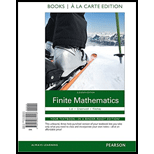
Concept explainers
If a teacher is currently ill, what is the probability that he or she will retire during the fallowing year? What is the probability that be or she will be ill again in the following year?
Answer to Problem 1EA
Solution: The probability that when the teacher will retire during the provided year is 0.139 and also the probability of her to fall ill again is 0.055.
Explanation of Solution
Given: Consider the summary provided in the textbook.
Explanation:
By the summary provided in the textbook,
The Markov chain model for teacher retention has 8 states: Resigned, Retired, Decreased,
New, Continuing, On Leave, On Sabbatical, and III.
The transition matrix for the one-year period is provided as:
The entry that is in row 8 and column 2 of the transition matrix is 0.139.
So, the probability that the teacher will retire during the provided year is 0.139.
Also, it can be seen that the entry in the row 8 and column 8 of the transition matrix is 0.055.
Hence, the probability that the teacher will be ill again is 0.055.
Conclusion: The probability when the teacher will retire during the provided year is 0.139 and also the probability of her to fall ill again is 0.055.
Want to see more full solutions like this?
Chapter 10 Solutions
Finite Mathematics, Books a la Carte Plus MyLab Math Access Card Package (11th Edition)
- Please explain how come of X2(n).arrow_forwardNo chatgpt pls will upvotearrow_forwardFind all solutions of the polynomial congruence x²+4x+1 = 0 (mod 143). (The solutions of the congruence x² + 4x+1=0 (mod 11) are x = 3,4 (mod 11) and the solutions of the congruence x² +4x+1 = 0 (mod 13) are x = 2,7 (mod 13).)arrow_forward
- https://www.hawkeslearning.com/Statistics/dbs2/datasets.htmlarrow_forwardDetermine whether each function is an injection and determine whether each is a surjection.The notation Z_(n) refers to the set {0,1,2,...,n-1}. For example, Z_(4)={0,1,2,3}. f: Z_(6) -> Z_(6) defined by f(x)=x^(2)+4(mod6). g: Z_(5) -> Z_(5) defined by g(x)=x^(2)-11(mod5). h: Z*Z -> Z defined by h(x,y)=x+2y. j: R-{3} -> R defined by j(x)=(4x)/(x-3).arrow_forwardDetermine whether each function is an injection and determine whether each is a surjection.arrow_forward
- Let A = {a, b, c, d}, B = {a,b,c}, and C = {s, t, u,v}. Draw an arrow diagram of a function for each of the following descriptions. If no such function exists, briefly explain why. (a) A function f : AC whose range is the set C. (b) A function g: BC whose range is the set C. (c) A function g: BC that is injective. (d) A function j : A → C that is not bijective.arrow_forwardLet f:R->R be defined by f(x)=x^(3)+5.(a) Determine if f is injective. why?(b) Determine if f is surjective. why?(c) Based upon (a) and (b), is f bijective? why?arrow_forwardLet f:R->R be defined by f(x)=x^(3)+5.(a) Determine if f is injective.(b) Determine if f is surjective. (c) Based upon (a) and (b), is f bijective?arrow_forward
 Holt Mcdougal Larson Pre-algebra: Student Edition...AlgebraISBN:9780547587776Author:HOLT MCDOUGALPublisher:HOLT MCDOUGAL
Holt Mcdougal Larson Pre-algebra: Student Edition...AlgebraISBN:9780547587776Author:HOLT MCDOUGALPublisher:HOLT MCDOUGAL College Algebra (MindTap Course List)AlgebraISBN:9781305652231Author:R. David Gustafson, Jeff HughesPublisher:Cengage Learning
College Algebra (MindTap Course List)AlgebraISBN:9781305652231Author:R. David Gustafson, Jeff HughesPublisher:Cengage Learning


